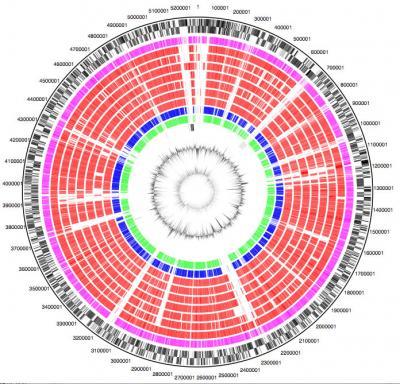Ten variants of the deadly Escherichia coli strain from Germany in May 2011 have been sequenced across the world - which may speed insight into how the outbreak arose.
The outbreak of E. coli O104:H4 resulted in a large number of cases of bloody diarrhoea and haemolytic uraemic syndrome (HUS) in Germany, and in 15 other countries in Europe and North America. The earliest studies suggested contaminated cucumbers were to blame. However by June 10th, raw beansprouts (once again - do not eat raw beansprouts ever, organic or not) were identified as the source of infection. Over 4,000 cases and around 50 deaths have occurred so far across 16 countries in Europe and North America. The outbreak has also had a very high economic impact on the organic food market across Europe.
Sequencing of the bacterium started in early June at BGI, China. Their sequence was provided in draft form to the scientific community as a crowd-sourcing project. This allowed scientists to identify key disease-causing genes. Dr Lisa Crossman, Microbial Genome Project Leader at TGAC, explained, "We have found that the E. coli strain responsible for the outbreak carries a very high number of genes known to be involved in disease. These include genes that influence the bacterium's ability to attach to surfaces and survival genes that increase tolerance to high acidity, low oxygen, UV light and antibiotics."

Circular diagram comparing the chromosomes of E. coli strains. The red circles show genes shared between different E.coli strains, with the outermost red circle being E. coli 55989. The magenta circle shows the 2001 outbreak strain, whilst the blue and green circles show genes shared with a Salmonella and a Shigella, respectively. Matches to the Shiga toxin encoding virus are shown in black under the green circle. This virus was present in the 2001 outbreak strain, and in E. coli O157:H7, but not in 55989.
(Photo Credit: Lisa Crossman)
Crowd-sourcing researchers found that the outbreak strain is most closely related to a strain of E. coli originally isolated in Central Africa some years ago, which was responsible for cases of serious diarrhoea. "The E. coli O104:H4 outbreak strain has gained the ability to make a toxin from a bacterial virus source which has made it more dangerous," explained Dr Crossman.
The unprecedented global crowd-sourcing effort meant that in the very immediate term, doctors were able to distinguish this strain from others, said Crossman at the Society for General Microbiology's Autumn Conference 2011. "Knowing which antibiotic resistance genes are carried by the strain, for example, can provide us with more insight into the source of the outbreak and help us avoid similar outbreaks occurring in the future," she said.
Institutions around the world have now isolated ten different variants of E. coli O104:H4. "These variants represent a tremendous resource to examine this bug in a new, rapid and exciting way. By studying the genetic factors involved in the survival of this bacterium on surfaces, we hope to get an angle on how this organism has been able to get a foothold in the global food chain," suggested Dr Crossman.
Source: Society for General Microbiology